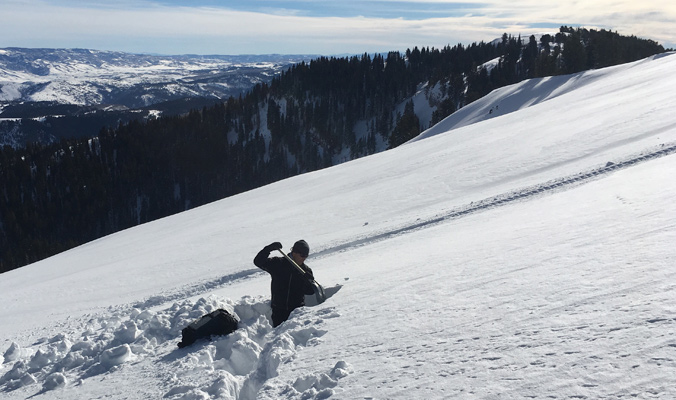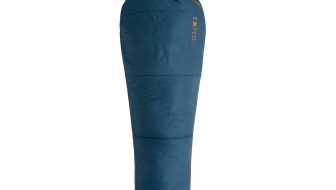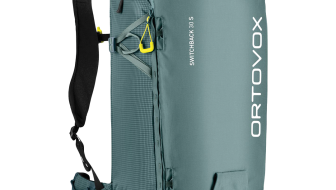
Mark Staples changes his perspective with a quick pit on the Manti-Skyline of Central Utah. [Photo] Brett Kobernik
In mid-December 2018, I was skiing on Kessler Peak in Utah’s Wasatch Mountains. Strong winds had ruined the skiing on many slopes, and we were searching for the few areas sheltered from the wind. We ascended a ridge and skied the lower part of a run called God’s Lawnmower. It was sheltered and the powder skiing was a five-star experience. After high fives, we figured that one good run deserved another and climbed back up to ski the adjacent run on a different aspect. As we crossed onto the other slope, we were excited to rip skins, then rip powder.
“Wait!” my partner said, as we readied to drop in for a second run. “Should we dig a quick pit?” It was mid-December, so digging was easy—the snowpack was only two feet deep. We decided, “Why not? Can’t hurt. Could help a little, maybe a lot. Let’s dig it.”
After 12 light taps on an extended column test, the entire column fractured on a layer of weak, faceted snow and quickly our perspective on the snowpack changed. Our excitement to ski was tempered by other emotions, so we stopped. We looked at a map and looked at the terrain to adjust our plan based on the new information from our quick pit. We would ski the aspect we’d previously chosen but would avoid anything steeper than 30 degrees.

Mark Staples digs a quick pit in the Bear River Range near Logan, Utah. [Photo] Toby Weed
I like to think of quick pits as a decision-making tool. Sometimes they provide life-saving info found under our feet. Regardless of what info they provide, quick pits improve our decision making by improving our communication and harnessing our emotions in a positive way by changing our perspective.
Before digging our snow pit on Kessler Peak, my partner and I had a simple plan—ski more great powder. After digging, we made a real plan. We decided where to ski, how to watch each other and most importantly, we communicated.
Every day, every group and every slope is different. What this means is that how we communicate can vary, but our lives depend it. Nearly every person in every avalanche accident says communication was a problem. One solution is to dig a snow pit. Standing in the snow pit provides us a moment to STOP and communicate—it gets people talking about potential hazards. I use quick pits all the time, not only because it’s my job, but because I’m tired, need a break, and it gives me a good opportunity to discuss avalanches with my partners.
There are many decision-making traps and pitfalls that most avalanche students learn and try to avoid. Having an awareness of heuristic traps is a good first step, but it does little to help us avoid them. Checklists and flow charts attempt to remove emotion from the decision-making process to combat these traps. But it’s impossible to remove emotion fully from our decision-making; we’re human.
When I was getting ready to ski my second run on Kessler, the lure of powder was tugging my emotions like a tractor beam pulling the Millennium Falcon to the Death Star. Since we can’t remove emotion, we should find a way to harness it to improve our decision-making. Changing our perspective is one way to do this. Standing in the snow pit that day changed by emotions from powder glee to apprehension, and when I reached the decision point at the top of the steep clearing, I turned away from it without thinking and lived to ski another day.










As a regular backcountry skier, 20 years and counting, avid pits have been a regular course of the day. If someone does not want to take the 20 min’s to add the info gained from a quick pit they are simply acting foolish.
You can get more info from non-standard test than you can get from a profile.
I will dig over 30 hand shears in s day with out removing my skis or pulling out a shovel and I’m on the move.
When I dig profiles or as you call them “pits” they’re used for records keeping, not decision making.
Most “pits” will not give you relevant info unless you Are in the start zone or path.
And don’t show a pic of a guy getting his obs from a shaved off snowcat birm..
24year snow pro and guide.
Hi J,
Thanks for your comments. I would encourage you or anyone to use standard tests like the ECT so that it’s a repeatable test. We’re not advocating doing a full profile. Just look for hard snow over soft snow and do one quick test. There are so many variables we can’t control, but what we can control is a clean pit wall, and a repeatable method.
As for the photo, that was a snowbike track deep in the backcountry. We used it since it was fresh and the pit was already halfway dug.
Pits give us tons of relevant information which is why we and all professionals dig them. They don’t have to be complicated which is why everyone should do them. They also help in so many other ways. Simply getting comfortable with your shovel is great rescue practice. Taking a moment to discuss stability and the snowpack with your group is another great reason. It only has to take 5 minutes and can save a life.
Have a great winter.
Mark Staples